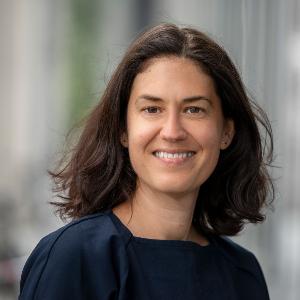Submarine symbiosis
11 Jul 2023
Professor Annika Guse, new to LMU, conducts research into corals, including at the cellular level.
11 Jul 2023
Professor Annika Guse, new to LMU, conducts research into corals, including at the cellular level.

researches symbiotic mechanisms and works to create more awareness for oceans and biodiversity. | © Tobias Schwerdt
For research purposes, Professor Annika Guse sometimes dives to coral reefs off the coast of Japan. Using miniature hammers, she chisels off samples from sexually mature colonies to observe them later on tables of flowing seawater. “At full moon, the coral releases sperm and eggs into the water once a year,” the biologist explains. The coral larvae also mature in buckets due to a nutrient symbiosis with a species of algae that has been added to the water, the dinoflagellates.
The symbiotic relationship between corals and these dinoflagellates is a focus of Annika Guse’s research. She has been chair of Quantitative Organismic Networks at LMU since April 2022. Even as a child growing up in North Rhine-Westphalia, Guse built herself a pond, created aquariums, and loved snorkeling in the sea. She studied biology at the TU Braunschweig and wrote her diploma thesis in biochemistry on the subject of bacteria. For her subsequent doctorate, she went to the University of Vienna’s Research Institute of Molecular Pathology. While there, she used model systems such as the nematode C. elegans to investigate the mechanisms of cell division and the distribution of genetic material “to understand, among other things, the principles of cancerous diseases.”
To get back to nature, Guse then spent a year traveling through South and Central America. During that time, she volunteered on reforestation projects in Costa Rica’s cloud forest and in coral reef monitoring in Mexico. Shortly thereafter, she went to Stanford University as a postdoctoral researcher to work on cell division using the African clawed frog model system. She then went on to do research as part of an Emmy Noether Program at Heidelberg University using the marine sea anemone as a model system, which, like coral, belongs to the phylum of sponges. “I began studying the symbiosis between photosynthetic dinoflagellates and anemones in the lab, doing comparative field work on coral reefs in Japan.”
These symbiotic mechanisms are still the focus of her research now that she is at LMU. In her lab, which is part of the Center for Organismic Adaptation (CORA), Guse works with methods from the fields of biochemistry, bioinformatics, genetics, and cell biology — and recapitulates reproductive behavior, larval stage, and the onset of symbiosis in corals using the sea anemone as the model system. “We use blue light to simulate a full moon to stimulate the production of eggs and sperm in our anemones. We mix the larvae with algae and observe the establishment, maintenance, and breakdown of this symbiosis.” This, she explains, enables the team to follow the cell biology that happens during the symbiotic establishment of corals in the early larval stage.
Questions Annika Guse asks about the symbiosis of corals and dinoflagellates are: How do the two cells find each other, how do they communicate, and how do they exchange nutrients? “Because it’s this nutritional symbiosis that brings the two species together, ensuring the survival of corals in nutrient-poor tropical seas,” Guse explains. “It’s the only way they can build these incredible ecosystems that coral reefs represent.” Guse explores these mechanisms on multiple levels — from molecules to cells to organisms to their environment. What she is focusing on in particular is the ability of two different organisms to adapt to difficult environments as a result of the symbiosis.
“These mechanisms are also of significance for evolutionary research — for example for our understanding of the origin of the eukaryotic cell, which also came about through the symbiosis of two organisms.” She has just secured a DFG grant related to the effects of light on coral reefs and plans to move forward “from mechanistic biology” to ecology.
The concept of symbiosis is also the inspiration behind the ¡vamos, simbiosis! art project that Annika Guse has initiated with her sister, the artist Stephanie Guse. Part of their aim for the project is to create more awareness on an emotional level around the protection of oceans and biodiversity — through the symbiosis of research and art.